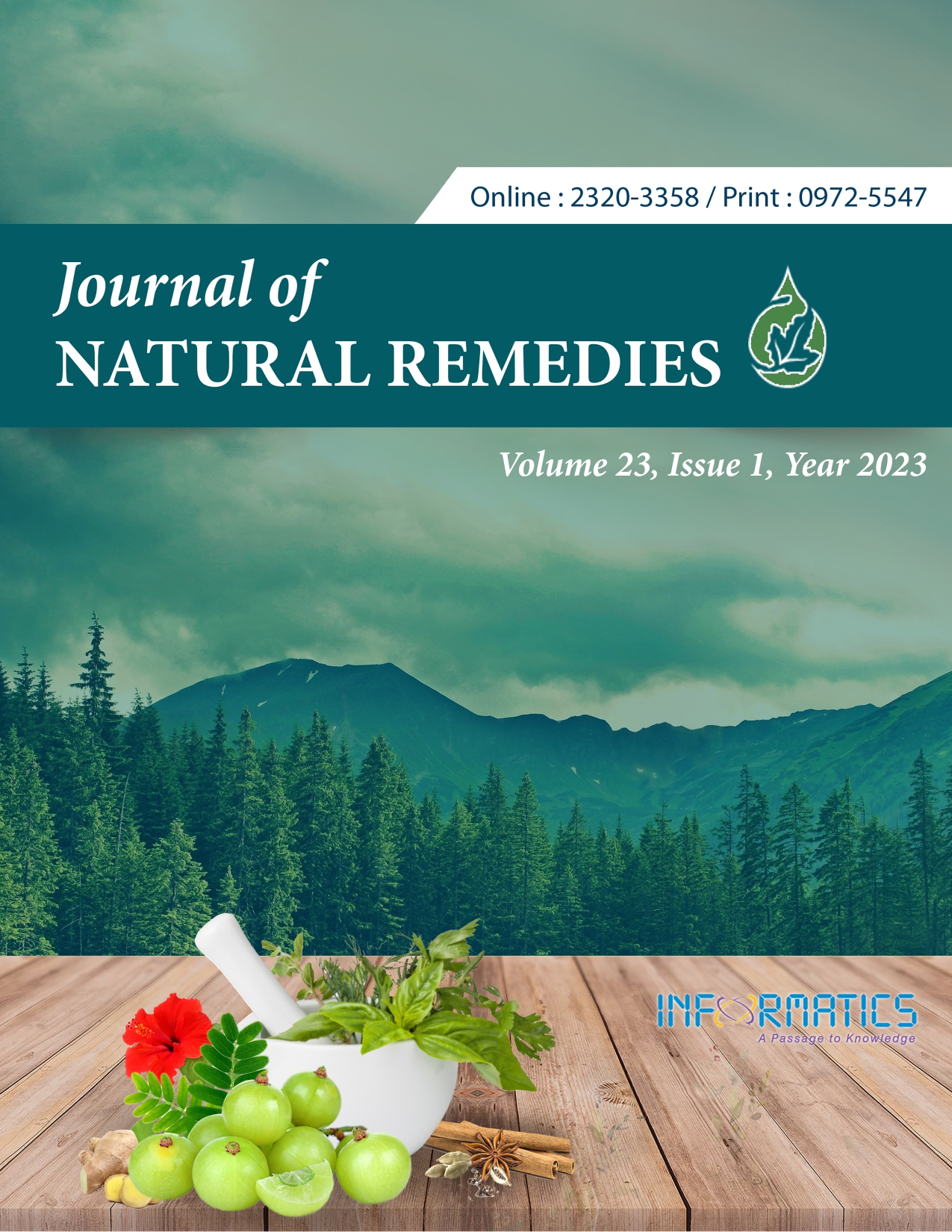Ethnobotany and Antimicrobial Activity of Traditional Plant -Holotelea integrifolia
DOI:
https://doi.org/10.18311/jnr/2023/31899Keywords:
Antimicrobial, Ethnobotany, Phytoconstituents, Standardization.Abstract
Holoptelea integrifolia (Ulmaceae) is a diversely used in Traditional Systems of medicine for healing aliments. The plant is preferred in the treatment and curing diseases like leprosy, inflammation, rickets, leucoderma, scabies, rheumatism, eczema, malaria and many more. The plants exhibits various pharmacological activities like antimicrobial, nociceptive, antiaging ,inflammation, anthelmintic, antidiabetic, adaptogenic, anticancer, wound healing, hepatoprotective, and hypolipidemic. The study on moprphological and microscopical was carried out on this plant as per the standards laid down by who to find the genuinity of the species. Physical constant values involving moisture content, ash and extractives as well as qualitative and quantitative estimation of various phytochemical have been studied. The presence of Saponins, Tannins, Terpenoids, Steroid, Flavonoids, and some other chemical constituents were recorded followed by antimicrobial activity of the plant against Gram Positive and Gram Negative Bacteria. Looking forward with the potential aspects of the plant used in Traditional system standardization parameters were to be considered for its validation and authentication.
Downloads
Metrics
Downloads
Published
How to Cite
Issue
Section
License
Copyright (c) 2023 Gunosindhu Chakraborthy, Snigdha Das Mandal, Rupal K. Jani (Author)

This work is licensed under a Creative Commons Attribution 4.0 International License.
Accepted 2023-09-05
Published 2023-03-23
References
Mahmud S, Shareef H, Ahmad M, Gouhar S, Rizwani GH. Pharmacognostical Studies on Fresh Leaves of Holoptelea integrifolia (Roxb.). PJB. 2010; 42(6):3705- 708. http://www.pakbs.org/pjbot/PDFs/42(6)/ PJB42(6)3705.pdf
Kumar D, Kumar K, Gupta J, Bishnoi N, Kumar S. A mini review on chemistry and biology of Holoptelea integrifolia Roxb. Planch (Ulmaceae). APTJB. 2012; 2(2):S1200-S1205.http://doi10.1016/S2221- 1691(12)60384-0 DOI: https://doi.org/10.1016/S2221-1691(12)60384-0
Pramod SG, Jayanthi MK, Reddy Prasad C. A study to evaluate and compare the anti-inflammatory activity of ethanolic and aqueous extract of Holoptelea integrifolia leaves on acute inflammatory models. IJBCP. 2016; 5(5):1780-784. http://dx.doi. org/10.18203/2319-2003.ijbcp20162870 DOI: https://doi.org/10.18203/2319-2003.ijbcp20162870
Acharya D. Monkey’s favourite seasonal fruit: Holoptelea integrifolia. American Chronicle. 2008; 1-5.
Lakshmi KS, Shrinivas SS, Rajesh T, Chitra V. Antitumor activity of ethanolic extract of leaves of Holoptelea integrifolia on Dalton’s ascetic lymphoma in Swiss albino mice. IJGP. 2010; 4(1): 44-47. https:// doi.org/10.4103/0973-8258.62164 DOI: https://doi.org/10.4103/0973-8258.62164
Puri S, Kumar B, Debnath J, Tiwari P, Salhan M, Kaur M, Mittal A. Comparative pharmacological Evaluation of adaptogenic activity of Holoptele integrifolia and Withania somnifera. IJDDR. 2011; 3(1):84-98. https://www.itmedicalteam.pl/articles/ comparative-pharmacological-evaluation-of adaptogenic-activity-of-holoptelea-integrifolia-and withania-somnifera.pdf
Srinivas RB, Kiran KKR, Naidu VG, Madhusudhana K, Agwane SB, Ramakrishna S, Diwan PV. Evaluation of antimicrobial, antioxidant and Wound Healing Potentials of Holoptelea integrifolia. J Ethnopharmacol. 2008; 115(2):249-56. https://doi. org/10.1016/j.jep.2007.09.031 DOI: https://doi.org/10.1016/j.jep.2007.09.031
Sharma J, Singh V. Holopetela integrifolia: An Overview. EJAS. 2012; 4(1):42-46. https://www.idosi. org/ejas/4(1)12/7.pdf
Roopashree TS, Dang R, Rani RHS, Narendra C. Antibacterial activity of antipsoriatic herbs: Cassia tora, Momordica charantia and Calendula officinalis, IJARNP. 2008; 1(3):20–8. https://www.oalib.com/ paper/2587381
Sass JE. Elements of Botanical Microtechnique, New York: Mc Graw Hill Book Co; 1940.
Johansen DA. Plant Microtechnique, New York: MC Graw Hill Book Co. 1940.
O’Brien TP, Feder N, Mc Cull ME. Polychromatic Staining of Plant Cell walls by toluidine Blue-O-. Protoplasma.1964; 59:364-373. https://doi. org/10.1007/BF01248568 DOI: https://doi.org/10.1007/BF01248568
Easu K. Plant Anatomy, New York: John Wiley and Sons. 1964.
Chase CR, Pratt RJ. Fluorescence of Powdered Vegetable Drugs with Particular Reference to Development of a System of Identification. APAS. 1949; 38:324. https://doi.org/10.1002/jps.3030380612 DOI: https://doi.org/10.1002/jps.3030380612
Kokate CK. Practical Pharmacognosy. New Delhi: Vallabh Prakashan. 2005.
Harbone JB. Phytochemical Methods – A Guide To Modern Techniques of Plant Analysis. London: Chapman and Hall London. 1998.
Florey HW, Chain E, Florey ME. The Antibiotic, New York: Oxford University Press.1989.
Indian Pharmacopoeia, Controller of Publications, Delhi. 1996

 Gunosindhu Chakraborthy
Gunosindhu Chakraborthy









 0.35
0.35 24
24 0.161
0.161